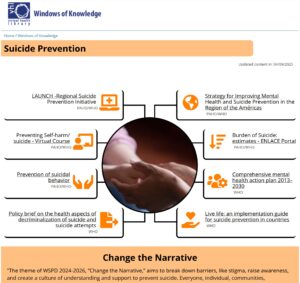September 10 is celebrated internationally as World Suicide Prevention Day, an event organized by the International Association for Suicide Prevention (IASP) and endorsed by the World Health Organization (WHO). The day’s fundamental purpose is to raise awareness about the reality of suicide and reaffirm that it can be prevented.
The magnitude of the problem. Every year, hundreds of thousands of people take their own lives worldwide, with serious impacts on families, communities, and health systems. Many of these deaths could be prevented with timely interventions, access to mental health care, social support networks, responsible communication, and effective public policies.
In the Region of the Americas, recent data indicate that the absolute number of suicides remains high, and although some countries are making progress, many face growing challenges, including underreporting, lack of consolidated national strategies, and lack of resources to implement evidence-based interventions.
Theme and approach for 2025 for World Suicide Prevention Day 2025 is “Changing the narrative on suicide.” This proposal invites society (governments, institutions, media, health professionals, and communities) to challenge stigmas, revisit ways to promote open dialogue, strengthen support practices, and ensure that suicide prevention is not just talk, but integrated, sustained, and evidence-based action.
PAHO Regional Initiative
Recognizing the growing urgency, the Pan American Health Organization (PAHO) launched the Regional Suicide Prevention Initiative on September 11, 2025, with the goal of strengthening national capacities to reduce suicide mortality in the Americas. This initiative emphasizes evidence-based interventions, such as those described in the WHO LIVE LIFE guide, and will provide technical support to countries with high or rising rates.

BIREME, as a specialized PAHO/WHO center for scientific and technical health information, offers a Window of Knowledge on Suicide Prevention, with open access documents, technical guides, research outcomes, and educational materials to support the formulation of effective policies and practices.
Challenges identified for suicide prevention include gaps in monitoring and data quality on suicide and suicide attempts; social stigmas that prevent people at risk from seeking or receiving help; lack of universal access to quality mental health services; the need to integrate prevention actions across multiple sectors (education, work, media, social services etc.) and consistent funding for prevention programs.
On the other hand, there are also opportunities: the growth of community strategies, international recognition that suicide is a public health issue that requires cross-cutting action, and the development of communication materials and campaigns that promote understanding, empathy, and preventive action.
Suicide prevention requires collective commitment: governments must develop robust national policies, integrate mental health programs into primary care, and protect vulnerable populations; health professionals, the media, and civil society organizations play an essential role in shaping narratives that reduce stigma and promote listening and support; communities—including families, schools, and workplaces—can create support networks and environments that welcome those who are suffering.
Informational resources
PAHO/WHO Regional Suicide Prevention Initiative
WHO World Suicide Prevention Day 2025
International Association for Suicide Prevention – World Suicide Prevention Day 2025